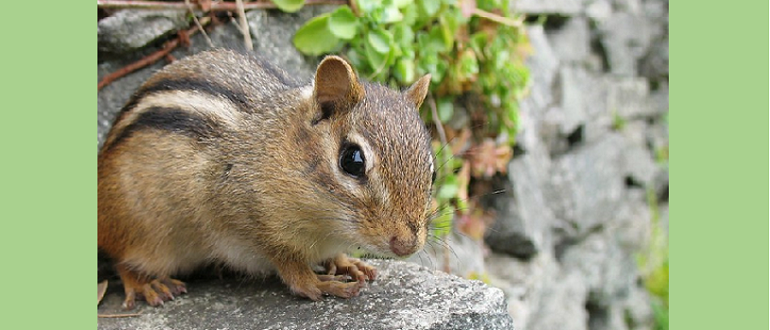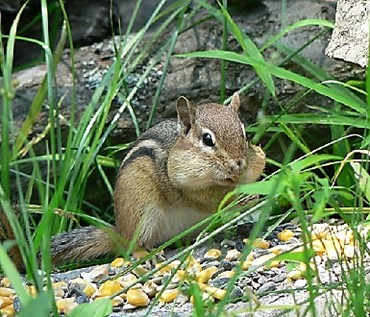Eastern Chipmunk (Tamias striatus) – photo by Gilles Gonthier CC-BY-2.0
GET TO KNOW
Eastern chipmunks
As well-known and beloved cartoon characters, “The Chipmunks” (think “Alvin”) have starred in multiple movies / TV shows and earned three Grammy’s, a Golden Globe and their own sidewalk star on the Hollywood “Walk of Fame”.
FUN FACT: It is fun to watch a chipmunk scurry and scamper about, but it is even more fun to watch one swim. As it turns out, chipmunks can swim when they want to. Watch this short video to see a chipmunk swim all the way across a pond. (Watch here.)
Yet in real life, chipmunks are widely despised and subjected to cruel methods of eradication. But why? Why all the hate?
It appears that chipmunks are basically victims of the powerful and highly profitable pest control industry which paints these adorable fuzzballs as demons of wanton destruction. But contrary to popular belief, chipmunks do not cause great harm to building foundations, attics or cars. They live underground – not in home attics. And while they do dig tunnels, their tunnels are small and not a danger to foundations. Remember, these are very small, little creatures, and they dig small, little tunnels.
Unfortunately, it seems that almost every article (written about chipmunks) repeats the standard refrain about chipmunks and property damage. Thus, the accusation is endlessly repeated –and believed. Many articles also carelessly list chipmunks as “possible” home/vehicle invaders without acknowledging that chipmunks do not want to nest inside (or be confined within) man-made structures. Any chipmunk incursion to the indoors is purely accidental and a source of great stress to the poor chipmunk.
Ironically, many such articles are authored by individuals within the pest control industry. Additionally, on numerous wildlife sites (even those at the level of state agencies) the paragraphs about “chipmunks and property damage” seem to be copied (often verbatim) directly from one article to the next and from pest control websites.
Conversely, the Humane Society of the United States, has a current campaign to change the public’s misconceptions that chipmunks cause damage to property. In their own words, the Humane Society is “fighting for chipmunks” so that chipmunks retain the simple right to exist. (Please see HS-USA for a series of four articles about chipmunks.)
It is true that chipmunks may nibble on the occasional garden bulb or plant, but overall, they are not the true culprits of any significant garden damage. Rather, chipmunks are garden helpers as they spread seeds around and munch on numerous insects. In fact, chipmunks have proven to be especially helpful in facilitating the complex symbiotic relationships (known as mycorrhizae) between plants and fungi whereby fungi colonize the roots of specific plants thereby increasing the plant’s ability to absorb water and nutrients. The science of studying mycorrhizae relationships is relatively new, but researchers have discovered that chipmunks, when present, play a positive role in spreading fungi to plant root structures.
LIFESTYLE AND HABITAT
The chipmunks seen scampering about the Rouge River watershed are Eastern chipmunks (Tamias striatus). They are small (4” – 6” plus tail) members of the rodent order in the squirrel (sciuridae) family. Solitary by nature, chipmunks live alone in underground tunnel homes. Each chipmunk likely maintains several shallow tunnels for quick daytime escape/shelter plus a deeper primary den that has multiple chambers for living, storing food and eliminating waste.
In northern climates with cold winters, chipmunks are active only during the warmer months. During cold weather, they spend several months in a semi-dormant state. With both lowered metabolism and limited activity, chipmunks can safely remain inside their tunnel home while feeding on stored seeds. Only on occasional, warm and sunny winter days, do these little creatures venture out to replenish food stores.
While woodlands are their most preferred habitats, chipmunks aren’t picky and have adapted quite well to life in the suburbs. Any field, park, yard or garden with sufficient ground cover can serve the needs of a chipmunk, but the ground beneath backyard bird feeders always offers the finest in prime dining for our suburban chipmunks!
Each chipmunk defends only a small territory immediately surrounding its tunnel home. Males leave their territories during breeding seasons to look for neighboring females, and all chipmunks search for food across larger, overlapping areas. While chipmunks can climb, they do not have the strength and climbing skills of other members of the squirrel family. Consequently, chipmunks are primarily ground feeders. As omnivores, they feed on a smorgasbord of fruits, nuts, seeds, insects and they occasional bit of carrion.
Like most tiny mammals, chipmunks are heavily preyed upon by raptors, foxes, snakes, raccoons, dogs, cats, and many others. Consequently, most chipmunks survive for only a short life span of two to three years. During that brief time, females generally have two litters per summer season. Born blind and helpless, tiny baby chipmunks stay entirely within the mother’s den for their first four to six weeks before setting off on their own before their first winter.
TAKE ACTION
Chipmunks are a normal and beneficial part of woodland ecosystems; and, in suburbia, they are harmless little neighbors. The biggest threat to chipmunks is the widespread belief that they are destructive to property and, therefore, “must be eradicated”.
You can help chipmunks survive within our watershed by simply allowing them to co-exist in our neighborhoods. Help counter the misconceptions about chipmunks and simply let them be.
Categories
-
News & EventsLearn more about upcoming FOTR events and projects

